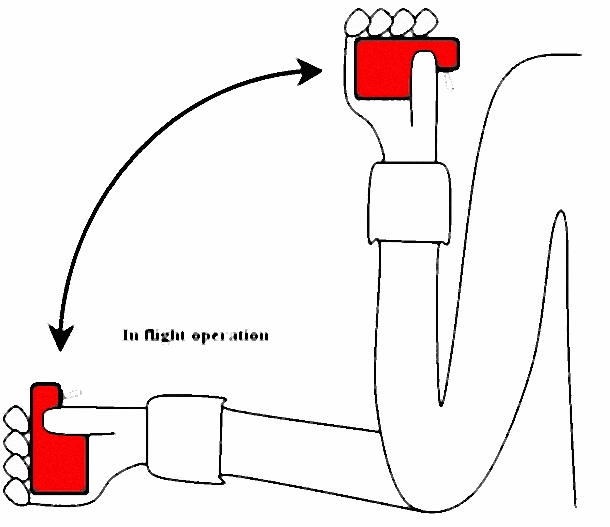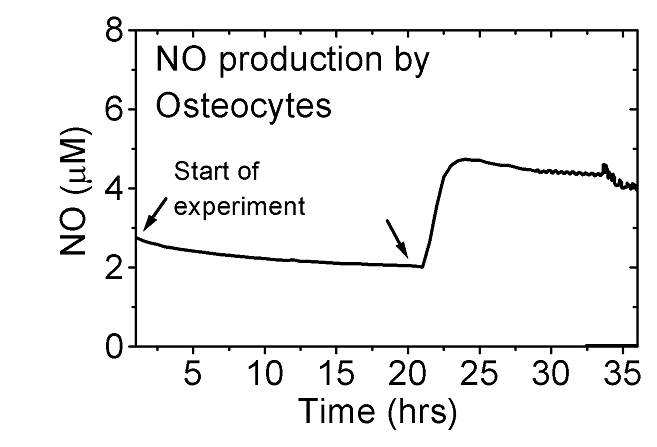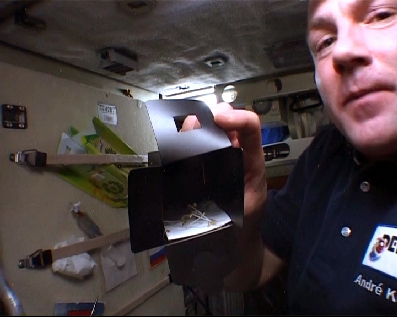|
DELTA-ICE-1st :
International
Ceonorhabditis elegans Experiment First flight
Science Goals and
Objectives
The first International
C. elegans Experiment (ICE-first), investigates several scientific
domains. This unique opportunity provided to the science community
gathered by the French space agency (CNES) and kindly offered by the
European Space Agency and the Space research organisation of the Netherlands
(SRON) is welcoming groups of scientists from France, Canada, Japan
and United States of America.
Caenorhabditis elegans is a nematode (Phylum Nematoda) measuring around
1mm and living naturally in soil. It is of no economic importance
to man. It has reproductive, nervous, muscular, and digestive systems.
It is a very simple organism made of a fixed number of somatic cells
(959). Its life span is about 2-3 weeks and in the liquid medium at
25°, the life cycle is around 5 days. The genome is totally sequenced
(100 000 000 of base pairs and around 20 000 genes). Numerous mutants
are available. It is used as a model system for various medical pathologies
and was the subject of the 2002 Nobel Prize in Medicine or Physiology
because the process of apoptosis or programmed cell death was discovered
while studying C. elegans development. Around the world many hundreds
of scientists are working full time investigating its biology. C.
elegans is about as primitive an organism that exists which nonetheless
shares many of the essential biological characteristics that are central
problems of human biology. The worm is conceived as a single cell
which undergoes a complex process of development. Then lineage of
the 959 cells is fixed and well known allowing a huge number of investigations
in fundamental biology. Scientists study embryogenesis, morphogenesis,
development, nerve function, behavior and aging. C. elegans may be
handled as a micro-organism. Thus it provides the researcher with
the ideal compromise between complexity and tractability. Different
studies have been performed during the DELTA mission.
1. Studies on genome stability
(Ann Rose, Canada).
We will take advantage of the suitability of genetic approaches on
C. elegans to address the genome stability question
by analysing the distribution of an antigen (mdf-2) which is essential
for the normal divisions of the cells. An alteration of the production
of this antigen will lead to the accumulation of defects including
chromosome abnormalities, X-chromosome non-disjunction or loss, problems
in gonad development, and embryonic lethality (Kitagawa & Rose,
1999). Another way to evaluate the effect of radiation is to study
the G-tracks which are present in the genome.
The preliminary results have been presented at the ASGSB meeting in
2004 (Worms in Space? A Model Biological Dosimeter; Yang Zhao, Robert
Johnsen, David Baillie and Ann Rose).
2. Studies on muscle
growth and survival (Catharine Conley USA; and Laurent Ségalat,
France).
Microgravity has
an important impact on muscle physiology and growth. C. elegans has
muscles which are analogous to vertebrates in terms of composition
and basic organisation. Investigations on C. elegans would benefit
from a large number of mutants available in this organism. In this
first study, emphasis would be put on two sets of genes : the localization
of Tropomodulin proteins and other contractile proteins of muscle
have been investigated. The phenotype of animal mutants for genes
encoding protein involved in muscle survival has been analyzed,specifically
the dystrophin, the product of the gene mutated in Duchêne Muscular
Dystrophy. The effect of microgravity on other mutations affecting
C. elegans muscle survival (including MyoD, perlecan, titin) are under
study using immucytochemistry and microscopy..
3. Whole-genome
microarray analysis of responses to spaceflight in C. elegans
(Catharine Conley, Stuart Kim USA)
The proposed experiment involves performing RNA expression analysis
using a microarray designed to probe for nearly every gene in the
genome. Although microarray analysis does not provide detailed information
concerning the function of any particular gene, its acts as an efficient
indicator of which genes might be interesting to study further, because
they show altered expression in response to the treatment. Two hypotheses
that can be tested directly using microarray data a) that radiation-repair
genes will be up-regulated, and b) that genes involved in muscle specification
and contractility will be down-regulated. Additional hypotheses concerning
worm 'immune' function and aging can also be tested, by determining
the expression of genes known to be involved in those physiological
processes. The sample received from space and ground experiment are
under study at ARC.
4. Morphometry
of larval C. elegans development during spaceflight. (Catherine
Conley, Beverly Girten, USA) In liquid CeMM, the media used in the
ICE flight, larvae shed cuticles as they molt and progress to the
next developmental stage are measured to study the range of lengths
exhibited by shed cuticles in media from cultures that have been returned
alive. The distribution of length data will indicate the number and
progression of larval moults during development in space.
5. Effect of space flight
on cell migration and muscle cell in C. elegans development.
(Hiroaki Kagawa, Noriaki Ishioka, Japan) C. elegans has two muscle
tissues; pharynx for feeding and body wall muscle for locomotion.
The both correspond to heart and skeletal muscle of vertebrates. Recently
we found that muscle filament gene defect affect not only muscle function
but also muscle development. Additionally these mutant animals have
abnormal distal tip cell migration during the worm development. Abnormal
cell migration can easily be seen under microscope. For this experiment,
we use wild-type and thick filament abnormal mutant (unc-15), which
produce muscle filament but decreased function and have abnormal morphology
of distal tip cells. Thesamples are currently under study in japan
6. Studies on germ
line development including meiotic chromosomal dynamics and germ cell
apoptosis under microgravity condition (Atsushi Higashitani,
Noriaki Ishioka, Japan) In C. elegans, the sequence of changes in
chromosomal morphology during meiotic prophase 1, the oocyte maturation
and the germ cell apoptosis can be observed, and the molecular mechanisms
underlying these phenomena can be investigated with genetic approaches.
We will analyze the effects of microgravity on these phenomena using
the N2 wild-type and ced (cell death) mutant (ced-1) strain. This
experiment will require 100 to 1000 animals in each strain at mixed
developmental stages, in addition to 1G control of each sample in
space) fixed in flight for microscopic observations staining with
DAPI and several antibodies (histone H3 phosphorylation and methylation,
activated MAPK etc…).
7. Analysis of the aging
related protein aggregation and sarcomere integrity (Shuji
& Yuko Honda, Noriaki Ishioka Japan) To
examine the effects of space on protein-folding homeostasis in muscle
cells, we will analyze the aggregation of polyglutamine (polyQ) in
body wall muscle cells, using transgenic C. elegans (N2; Punc-54)expressing
polyQ-YFP (yellow fluorescent protein) and also daf-2(e1370) lifespan-extension
mutant. We will also analyze sarcomere orientation in the muscle of
transgenic C. elegans (N2; Punc-54) expressing GFP (green fluorescent
protein) in body wall muscle cells.
8. Description
of the Experiment
To fly the animals
have adapted to the liquid medium specially designed and provided
by NASA. Six days before the launch the strains have been prepared
for the flight by the investigators in the facility of the GSBMS (Groupement
Scientifique pour la Biologie et la Médecine Spatiale) in Toulouse.
According with a define scenario, some of the samples have been placed
in culture chambers (CCA) which enable a fixation by the end of the
flight. The others have been packed in 5.0 and 2.5 ml culture bags.
They have been all
togather then hand carried to the launch pad in Baikonour under controlled
temperature (12°C). After a final check of the samples in culture
bags by a scientist, they have been 12 hours before the launch in
vented Experiment Containers kindly provided by Prof. E. Horn from
Ulm (Germany).
The samples have
been delivered to the mission management to be placed in Kubik Topaz
with the other experiments and the temperature was set at 20°C.
The launch was uneventful for the worms. Three days after the launch,
the samples have been transferred to the Kubik Amber but the centrifuge
supposed to hold three small containers did not work. April the 25th
the containers ICE-01 et ICE-03 have been fixed while ICE-02 and ICE-04
have been fixed April 27th.
Right upon the landing
in Kazahkstan, the containers containing the culture Bags have been
open and some filmed to evaluate the behaviour of the animals. The
small bags containing the culture of the worms have been then either
frozen or refrigerated till their return in Toulouse two days after
the landing.
All the samples have then been forwarded to the investigators and
are now analyzed in the laboratories. Most of the samples are suitable
for the scientific purposes and the main results are planned
9. Acknowledgements
The science team
acknowledges the space agencies which are allowing this flight opportunity
as “l’Agence Spatiale Canadienne” (ASC), the “Centre
National d’Etudes Spatiales” (CNES), the European Space
Agency (ESA), the Japan Aerospace Exploration Agency (JAXA), the National
Aeronautic and Space Administration (NASA), and the Space Research
Organisation of the Netherlands (SRON).
|














 Crew In flight operation.
Crew In flight operation.













